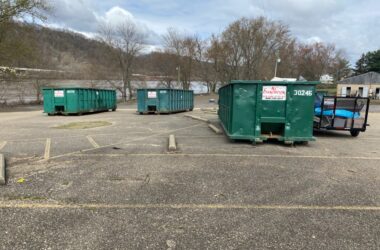The records of the First Company I, formed in the Spring of 1861 as ninety-day volunteers, list Richard Hooker Brown as a First Lieutenant. When the unit was reformed as a longer term service unit, records list him as a Private. Most sources list his dates of service from May 21, 1861 to June 16, 1865, (which encompasses the first three month enlistment) and show his entry rank as Private and his rank at discharge as Lieutenant Colonel and commander of the Regiment.
He was born in 1837 in Hollidays Cove. His father was Jacob Nessley Brown. His mother was Ann Myler. Jacob operated a flour mill at Wellsburg as well as a distillery on his farm in the Tomlinson Run area, along the Ohio River. Clay deposits on the farm allegedly were the first used in the local pottery industry, and were dedicated to making jugs to hold distilled spirits. The Colonel’s grandparents were Richard Brown and Barbara Nessley Brown, daughter of Jacob Nessley, associated with both the Blockhouse and the Chapel. His grandfather held the offices of sheriff, justice of the peace and surveyor, for Brooke County, prior to the creation of Hancock County. He also was an officer in a Maryland Regiment during the revolution and was referred to as Colonel Brown.
Biographical notes indicate Richard H. Brown was a graduate of Duff’s Business College located in Pittsburgh. That College was founded in 1840 and produced commercial professionals such as accountants.
After the war, he married Elizabeth Pugh of Pughtown. She was the daughter of David Pugh and Nancy Allison Pugh. The Colonel and Elizabeth had twelve children, of whom eleven survived into adulthood. His obituary indicates that he spent several years on the Board of Education, spent a term as one of the four County Judges, (presumably the position which was replaced by the County Commissioners acting as the County Court, and while Hancock County still had four districts, Poe District was eliminated in the 1920’s.) Finally he was also elected Sheriff of Hancock County and served from 1876 to 1880. His obituary described his Army service as: “Colonel Brown won considerable renown during the war for bravery, having fought in some of the most important battles of the contest.” East Liverpool Evening Review, Monday, 21 March, 1910, page 5. At the time of his death, which seems to have been from a stroke, his listed age was 73. Interestingly, his older sister Virginia, age 75, died twelve hours before him. They both lived on the farm, where services were held by the minister of Nessley Chapel, in which cemetery they are buried.
Considering the times, Richard Hooker Brown developed another association during the war which was both unusual and lifelong. William Wilson was a black man, born in Albemarle County, Virginia. According to the Brown family oral history, Wilson became a soldier in the Twelfth. According to my understanding of “colored troops”, they were placed into segregated units, commanded by white officers, not generally placed in existing units. However, the Twelfth did spend the final 18 months of the war in the Shenandoah Valley. Albemarle County, whose County Seat is Charlottesville, Virginia is in that region. Likely William Wilson left a farm or plantation where he was enslaved, and like many others started following the Union Armies, performing services and seeking food. In was not unusual for officers to take man-servants from this group, and provide them food, clothing and even money. Perhaps that was the start of the relationship between Colonel Brown and William Wilson. “Wilson was about sixteen years old when, after the close of the war he accompanied Colonel Brown to Hancock County and entered the employ of the latter’s sister, Miss Virginia, with whom he remained until her death.”
After the deaths of the Colonel and his sister, William Wilson “purchased a part of the Brown Farm and he is today one of the highly respected and very substantial citizens of Hancock County, his fidelity to the Brown family having never wavered and his service to the family having been of the most conscientious and appreciative order.” U.S. Biographies Project Hancock County West Virginia-Bios Brown, Austin H. (Published 1923.) I find it amazing that these words were spoken of William Wilson in 1923, when at the time when he acquired property from the Browns, and prior to then he was their foreman, there were fewer than 100 persons of color in Hancock County, according to census records. He passed away in December, 1933, at “about age 90” having been a farmer for 68 years. The informant on the death certificate appears to be Anna Brown Bowker, a daughter of the Colonel, who had previously resided in Rochester, NY. Wilson was buried at Nessley Chapel Cemetery.


